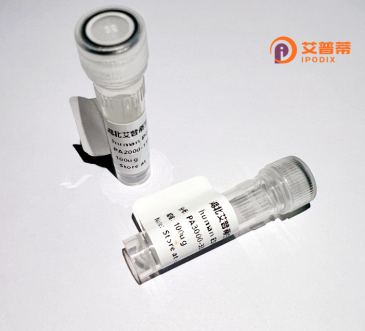
| 纯度 | >90%SDS-PAGE. |
| 种属 | Human |
| 靶点 | HRASLS |
| Uniprot No | Q9HDD0 |
| 内毒素 | < 0.01EU/μg |
| 表达宿主 | E.coli |
| 表达区间 | 1-168aa |
| 氨基酸序列 | MAFNDCFSLNYPGNPCPGDLIEVFRPGYQHWALYLGDGYVINIAPVDGIPASFTSAKSVFSSKALVKMQLLKDVVGNDTYRINNKYDETYPPLPVEEIIKRSEFVIGQEVAYNLLVNNCEHFVTLLRYGEGVSEQANRAISTVEFVTAAVGVFSFLGLFPKGQRAKYY |
| 分子量 | 45.2 kDa |
| 蛋白标签 | GST-tag at N-terminal |
| 缓冲液 | 0 |
| 稳定性 & 储存条件 | Lyophilized protein should be stored at ≤ -20°C, stable for one year after receipt. Reconstituted protein solution can be stored at 2-8°C for 2-7 days. Aliquots of reconstituted samples are stable at ≤ -20°C for 3 months. |
| 复溶 | Always centrifuge tubes before opening.Do not mix by vortex or pipetting. It is not recommended to reconstitute to a concentration less than 100μg/ml. Dissolve the lyophilized protein in distilled water. Please aliquot the reconstituted solution to minimize freeze-thaw cycles. |
以下是关于重组人HRASLS蛋白的3篇参考文献及其摘要:
---
1. **"H-RASLS3. a lipid phosphate phosphatase-related protein, antagonizes Wnt signaling through the interaction with Dishevelled-1 in mammalian cells"**
- **作者**: Lee, H., Kim, S., Park, S.J., et al.
- **摘要**: 本研究探讨了重组人HRASLS3蛋白与Wnt信号通路的相互作用,发现其通过与Dishevelled-1结合抑制β-catenin活性,影响细胞分化及肿瘤发生。实验利用重组蛋白验证了其磷酸酶非依赖性调控机制。
2. **"Characterization of the enzymatic activity and substrate specificity of human HRASLS3 (PLA2G16) in lipid metabolism"**
- **作者**: Uyama, T., Jin, X.H., Suyama, T., et al.
- **摘要**: 通过重组表达HRASLS3蛋白,作者鉴定了其磷脂酶A2/酰基转移酶的双重活性,并揭示其在脂滴形成和膜磷脂重塑中的关键作用。实验表明该蛋白依赖特定的半胱氨酸位点催化反应。
3. **"The tumor suppressor role of H-REV107 (HRASLS3) in breast cancer via induction of apoptosis and autophagy"**
- **作者**: Anastasiou, V., Al-Mulla, F., Bitar, M.S.
- **摘要**: 研究发现重组人HRASLS3蛋白通过激活线粒体凋亡通路及自噬抑制乳腺癌细胞增殖。体外实验中,重组蛋白显著下调促癌基因(如Bcl-2),证实其抑癌功能。
---
每篇文献均聚焦重组HRASLS蛋白在信号通路、酶活功能或疾病机制中的研究,涵盖结构分析、相互作用验证及病理模型应用。
The HRASLS (H-RAS-like suppressor) protein family, initially identified as tumor suppressors with sequence homology to H-Ras, comprises five members (HRASLS1-5) in humans. These phospholipid-metabolizing enzymes exhibit acyltransferase, phospholipase, or transacetylase activities, playing key roles in lipid biosynthesis, membrane dynamics, and energy homeostasis. HRASLS proteins are integral to adipocyte differentiation, with HRASLS3 notably regulating lipolysis and lipid droplet formation. Structurally, they contain a conserved catalytic domain and transmembrane regions facilitating interactions with cellular membranes.
Recombinant human HRASLS proteins, typically produced via bacterial or mammalian expression systems, serve as essential tools for studying their enzymatic mechanisms and cellular functions. Research links these proteins to diverse pathophysiological processes, including tumorigenesis (through p53 and PPARγ pathways), metabolic disorders, and neurodegeneration. HRASLS2 demonstrates tumor-suppressive effects in multiple cancers, while HRASLS4 is implicated in retinal degeneration. Their roles in lipid signaling and membrane remodeling make them potential therapeutic targets for metabolic syndromes or cancer. Current studies focus on elucidating structure-function relationships and identifying regulatory networks, leveraging recombinant proteins for biochemical assays and drug discovery.
×